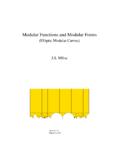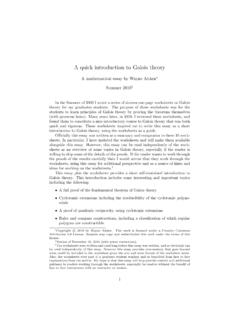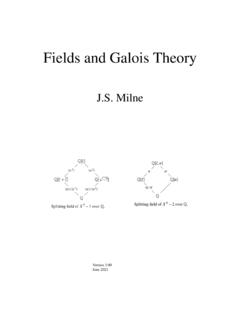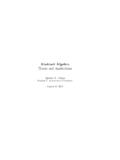Transcription of Algebraic Number Theory - James Milne
1 Algebraic Number Theory Milne Version March 18, 2017. An Algebraic Number field is a finite extension of Q; an Algebraic Number is an element of an Algebraic Number field. Algebraic Number Theory studies the arithmetic of Algebraic Number fields the ring of integers in the Number field, the ideals and units in the ring of integers, the extent to which unique factorization holds, and so on. An abelian extension of a field is a galois extension of the field with abelian galois group. Class field Theory describes the abelian extensions of a Number field in terms of the arithmetic of the field. These notes are concerned with Algebraic Number Theory , and the sequel with class field Theory . BibTeX information @misc{milneANT, author={ Milne , James S.}}
2 }, title={ Algebraic Number Theory ( )}, year={2017}, note={Available at }, pages={165}. }. (August 14, 1996). First version on the web. (August 31, 1998). Fixed many minor errors; added exercises and an index; 138 pages. (February 11, 2008). Corrected; revisions and additions; 163 pages. (September 28, 2008). Fixed problem with hyperlinks; 163 pages. (April 30, 2009). Fixed many minor errors; changed chapter and page styles; 164. pages. (May 29, 2011). Minor fixes; 167 pages. (April 12, 2012). Minor fixes. (March 21, 2013). Minor fixes. (May 28, 2014). Minor fixes; 164 pages. (March 18, 2017). Minor fixes; 165 pages. Available at Please send comments and corrections to me at The photograph is of the Fork Hut, Huxley Valley, New Zealand.
3 Copyright c 1996 2017 Milne . Single paper copies for noncommercial personal use may be made without explicit permission from the copyright holder. Contents Notations.. 4. Introduction .. 7. Exercises .. 12. 1 Preliminaries from Commutative Algebra 14. Basic definitions .. 14. Ideals in products of rings .. 15. Noetherian rings .. 15. Noetherian modules .. 16. Local rings .. 17. Rings of fractions .. 18. The Chinese remainder theorem .. 19. Review of tensor products .. 21. Exercise .. 24. 2 Rings of Integers 25. First proof that the integral elements form a ring .. 25. Dedekind's proof that the integral elements form a ring .. 26. Integral elements .. 28. Review of bases of A-modules .. 31. Review of norms and traces .. 31. Review of bilinear forms.
4 32. Discriminants .. 33. Rings of integers are finitely generated .. 35. Finding the ring of integers .. 37. Algorithms for finding the ring of integers .. 40. Exercises .. 44. 3 Dedekind Domains; Factorization 45. Discrete valuation rings .. 45. Dedekind domains .. 47. Unique factorization of ideals .. 48. The ideal class group .. 51. Discrete valuations .. 54. Integral closures of Dedekind domains .. 55. Modules over Dedekind domains (sketch).. 56. Factorization in extensions .. 57. The primes that ramify .. 59. 1. Finding factorizations .. 61. Examples of factorizations .. 62. Eisenstein extensions .. 64. Exercises .. 66. 4 The Finiteness of the Class Number 67. Norms of ideals .. 67. Statement of the main theorem and its consequences.
5 69. Lattices .. 72. Some calculus .. 76. Finiteness of the class Number .. 79. Binary quadratic forms .. 80. Exercises .. 82. 5 The Unit theorem 84. Statement of the theorem .. 84. Proof that UK is finitely generated .. 86. Computation of the rank .. 87. S -units .. 89. Example: CM fields .. 89. Example: real quadratic fields .. 90. Example: cubic fields with negative discriminant .. 91. Finding .K/ .. 92. Finding a system of fundamental units .. 92. Regulators .. 93. Exercises .. 93. 6 Cyclotomic Extensions; Fermat's Last theorem . 94. The basic results .. 94. Class numbers of cyclotomic fields .. 100. Units in cyclotomic fields .. 100. The first case of Fermat's last theorem for regular primes .. 101. Exercises .. 103. 7 Absolute Values; Local Fields 104.
6 Absolute Values .. 104. Nonarchimedean absolute values .. 105. Equivalent absolute values .. 106. Properties of discrete valuations .. 108. Complete list of absolute values for the rational numbers .. 108. The primes of a Number field .. 110. The weak approximation theorem .. 112. Completions .. 113. Completions in the nonarchimedean case .. 114. Newton's lemma .. 118. Extensions of nonarchimedean absolute values .. 122. Newton's polygon .. 123. Locally compact fields .. 125. Unramified extensions of a local field .. 126. Totally ramified extensions of K .. 128. Ramification groups .. 129. Krasner's lemma and applications .. 130. Exercises .. 132. 8 Global Fields 134. Extending absolute values .. 134. The product formula .. 136.
7 Decomposition groups .. 138. The Frobenius element .. 140. Examples .. 142. Computing galois groups (the hard way) .. 143. Computing galois groups (the easy way) .. 143. Applications of the Chebotarev density theorem .. 148. Finiteness Theorems .. 150. Exercises .. 151. A Solutions to the Exercises 152. B Two-hour examination 159. Bibliography 160. Index 162. Notations. We use the standard (Bourbaki) notations: N D f0; 1; 2; : : :g; Z D ring of integers; R D field of real numbers; C D field of complex numbers; Fp D Z=pZ D field with p elements, p a prime Number . For integers m and n, mjn means that m divides n, , n 2 mZ. Throughout the notes, p is a prime Number , , p D 2; 3; 5; : : :. Given an equivalence relation, denotes the equivalence class containing.
8 The empty set is denoted by ;. The cardinality of a set S is denoted by jS j (so jSj is the Number of elements in S when S is finite). Let I and A be sets; a family of elements of A indexed by I , denoted .ai /i 2I , is a function i 7! ai W I ! A. X Y X is a subset of Y (not necessarily proper);. def X DY X is defined to be Y , or equals Y by definition;. X Y X is isomorphic to Y ;. X 'Y X and Y are canonically isomorphic (or there is a given or unique isomorphism);. ,! denotes an injective map;. denotes a surjective map. monnnnn question nnnnn in It is standard to use Gothic (fraktur) letters for ideals: a b c m n p q A B C M N P Q. a b c m n p q A B C M N P Q. Prerequisites The algebra usually covered in a first-year graduate course, for example, galois Theory , group Theory , and multilinear algebra.
9 An undergraduate Number Theory course will also be helpful. References In addition to the references listed at the end and in footnotes, I shall refer to the following of my course notes (available at ): FT Fields and galois Theory , , 2017. GT Group Theory , , 2017. CFT Class Field Theory , , 2013. Acknowledgements I thank the following for providing corrections and comments for earlier versions of these notes: Vincenzo Acciaro; Michael Adler; Giedrius Alkauskas; Baraksha; Francesc Castella ;. Kwangho Choiy; Dustin Clausen; Keith Conrad; Edgar Costa, Paul Federbush; Georg Hein;. Florian Herzig; Dieter Hink; Hau-wen Huang; Enis Kaya; Keenan Kidwell; Roger Lipsett;. Loy Jiabao, Jasper; Lee M. Goswick; Samir Hasan; Lawrence Howe; Lars Kindler; Franz Lemmermeyer; Siddharth Mathur; Bijan Mohebi; Yogesh More; Scott Mullane; Safak Ozden; Wai Yan Pong; Nicola s Sirolli; Sam Spiro; Thomas Stoll; Bhupendra Nath Tiwari.
10 Vishne Uzi; and others. PARI is an open source computer algebra system freely available from 4. D RAMATIS P ERSON . F ERMAT (1601 1665). Stated his last theorem , and proved it for m D 4. He also posed the problem of finding integer solutions to the equation, X2 AY 2 D 1;. A 2 Z; (1). p which is essentially the problem1 of finding the units in Z A . The English mathematicians found an algorithm for solving the problem, but neglected to prove that the algorithm always works. E ULER (1707 1783). He introduced analysis into the study of the prime numbers, and he discovered an early version of the quadratic reciprocity law. L AGRANGE (1736 1813). He found the complete form of the quadratic reciprocity law: . p q D . 1/.p 1/.q 1/=4 ; p; q odd primes, q p and he proved that the algorithm for solving (1) always leads to a solution.


















